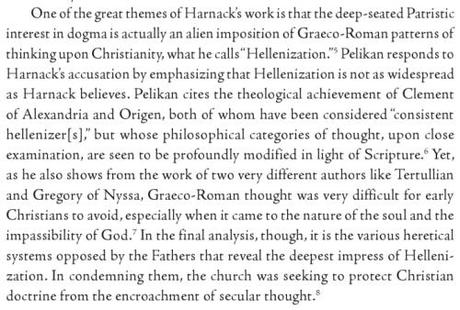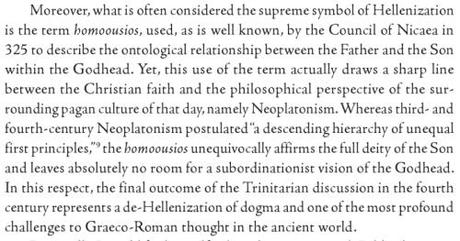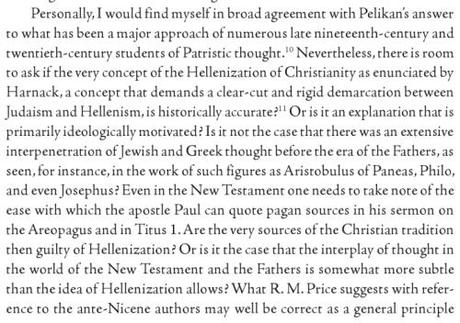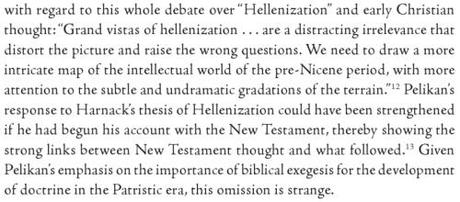Aujourd’hui, les adversaires du christianisme — et même certains chrétiens — se plaisent à affirmer que la systématisation de la théologie chrétienne par les Pères de l’Église en Antiquité tardive trahit une influence de la pensée hellénique païenne sur le christianisme. Il convient d’adresser cette thèse répandue.
Dans son ouvrage Réfutation de toutes les hérésies, Hippolyte de Rome (pasteur de l’assemblée chrétienne dans la ville de Rome de l’an 217 à 235) déploie beaucoup d’énergie à exposer l’origine et le caractère non-biblique de plusieurs courants religieux de son époque qui se prétendaient chrétiens. Un thème récurrent de l’ouvrage d’Hippolyte est l’identification de différentes erreurs qui voulaient contaminer le christianisme avec les différents systèmes de croyances païens du monde antique.
Ainsi, le docétisme est pour Hippolyte un dérivé de la philosophie sophiste, le marcionisme est un recyclage des enseignements du philosophe grec Empédocle, la doctrine d’Hermogène (selon laquelle Dieu créa le monde à partir de matière pré-existante) a sa source dans le socratisme, la doctrine de Colarbasus (selon laquelle l’entièreté de la vérité spirituelle est contenue dans l’alphabet grec) découle du pythagorisme, les dogmes de différentes sectes gnostiques sont dérivés de l’aristotélisme, de l’astrologie chaldéenne, de la religion égyptienne, ou encore sont des plagiats de la cosmogonie homérique. En identifiant les hérésies pseudo-chrétiennes aux diverses philosophies antiques, on voit qu’Hippolyte rejetait ces philosophies et les considérait incompatible avec le christianisme, et qu’il n’essayait pas de les concilier.
Source : Philip Schaff, Ante-Nicene Fathers, Volume 5 : Fathers of the Third Century – Hippolytus, Cyprian, Caius, Novatian, 1885. Christian Classics Ethereal Library, Calvin College, Grand Rapids (Michigan).
Dans deux de ses récents ouvrages, l’historien Michael Haykin (professeur au Southern Baptist Theological Seminary, Louisville, Kentucky) démolit la thèse selon laquelle la systématisation de la théologie chrétienne en Antiquité tardive trahit une influence de la pensée hellénique païenne sur le christianisme…




Source : Michael Haykin, Rediscovering the Church Fathers : Who They Were and How They Shaped the Church, Wheaton (Illinois), Crossway, 2011, p. 160-162 sur 172.
« In many respects, Basil [of Caesarea]’s main contribution to the history of dogma is his pneumatological thought. Born into a long-standing Christian family — both sets of grandparents suffered during the brutal persecution of Diocletian (c.245-c.312) — Basil’s conversion in 356 had come in the context of the early monastic movement that introduced him to an environment in which there was a distinct interest in the sanctifying work of the Holy Spirit. Basil’s experience of the Spirit in the monastic life was definitely a key factor in a growing concern he had with the question of the nature and person of the Holy Spirit. This personal interest coincided with a rapid increase in the 360s and 370s of ontological questions about the being of the Spirit, of which Athanasius’s dispute with certain individuals in Thmuis in the late 350s appears to have been a forerunner.
Those who opposed an expansion of the Nicene Creed to include a confession of the Spirit’s deity during this era would become known as Pneumatomachi, “fighters against the Spirit,” a word coinage based on Acts 5:39.
Basil’s classic study of the deity of the Holy Spirit played a pivotal role in shaping the third article of the Niceno-Constantinopolitan creed, but only slowly did he concede that an expansion of the Nicene Creed was necessary so as to include a statement about the deity of the Holy Spirit. Eventually, though, he could note in a letter written in 376 or 377 to Epiphanius (c.315-403), the bishop of Salamis: “We are unable to add anything to the Nicene creed, not even the smallest addition, except the glorification of the Holy Spirit, because our fathers made mention of this part [of the faith] cursorily, since at that time no controversial question concerning it had yet arisen.” In the end this need to expand the article about the Holy Spirit involved the drafting of a new creedal statement at the Council of Constantinople, which was and still is a major landmark in Christian theological reflection.
Although some historians have argued that this fourth-century creedal statement and the earlier one at Nicaea represents the apex of the Hellenization of the church’s teaching, in which fourth-century Christianity traded the vitality of the New Testament church’s experience of God for a cold, abstract philosophical formula, nothing could be further from the truth. The Niceno-Constantinopolitan creed helped to sum up a long process of reflection that had its origins in the Christian communities of the first century. The New Testament itself provides clear warrant for the direction that theological reflection upon the nature of God took in fourth-century Christian orthodoxy. As Douglas Ottati, an American professor of theology once put it, “Trinitarian theology continues a biblically initiated exploration.”
Or, in the words of the early twentieth-century theologian, the American Presbyterian Benjamin B. Warfield: the “doctrine of the Trinity lies in Scripture in solution; when it is crystallized from its solvent it does not cease to be Scriptural, but only comes into clearer view.”
This biblical foundation of the creed is especially true of the third article that deals with the Holy Spirit. Technical theological terminology as found in the use of the term “one in being” (homoousios) about the Son is eschewed in favour of simpler biblical tones. In the words of the Creed, the Holy Spirit in whom the Church believes is:
The Lord and the giver of life, who proceeds from the Father [and the Son]. With the Father and the Son he is worshipped and glorified. He has spoken through the Prophets.
The statement makes five distinct affirmations about the Holy Spirit:
1. He is Lord (kyrios).
2. He is the Giver of Life.
3. He proceeds from the Father [and the Son].
4. Together with the Father and the Son he is to be worshipped and glorified.
5. And he spoke through the prophets.
Let us look at each of these affirmations in turn, seeking to display the biblical roots of what is being affirmed. »
Source : Michael Haykin, The Empire of the Holy Spirit, Fayetteville (Arkansas), Border Stone Press, 2010, p. 5-8 sur 210. Lisez la suite gratuitement ici.
Lisez aussi :
- Tableau — Positionnement théologique des Pères de l’Église [Le Monarchomaque]
- Defending the Holy Spirit’s Deity : Basil of Caesarea, Gregory of Nyssa, and the Pneumatomachian Controversy of the 4th Century [Southern Baptist Journal of Theology]

